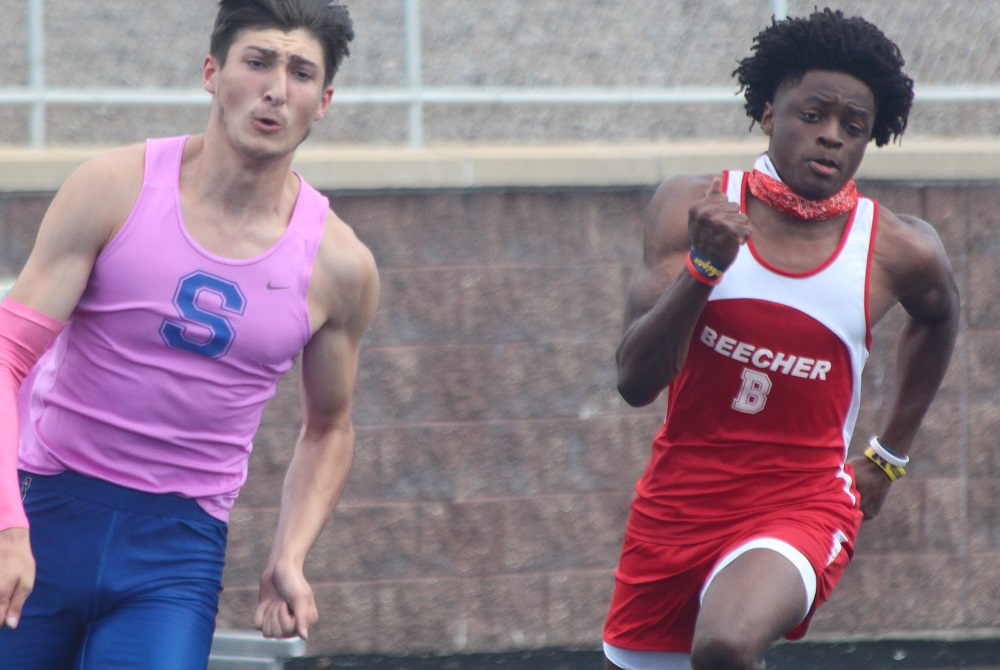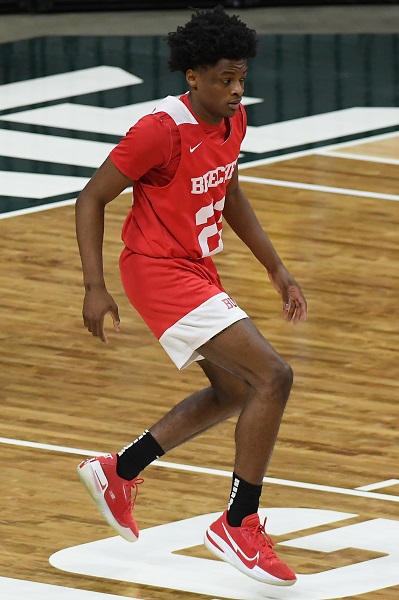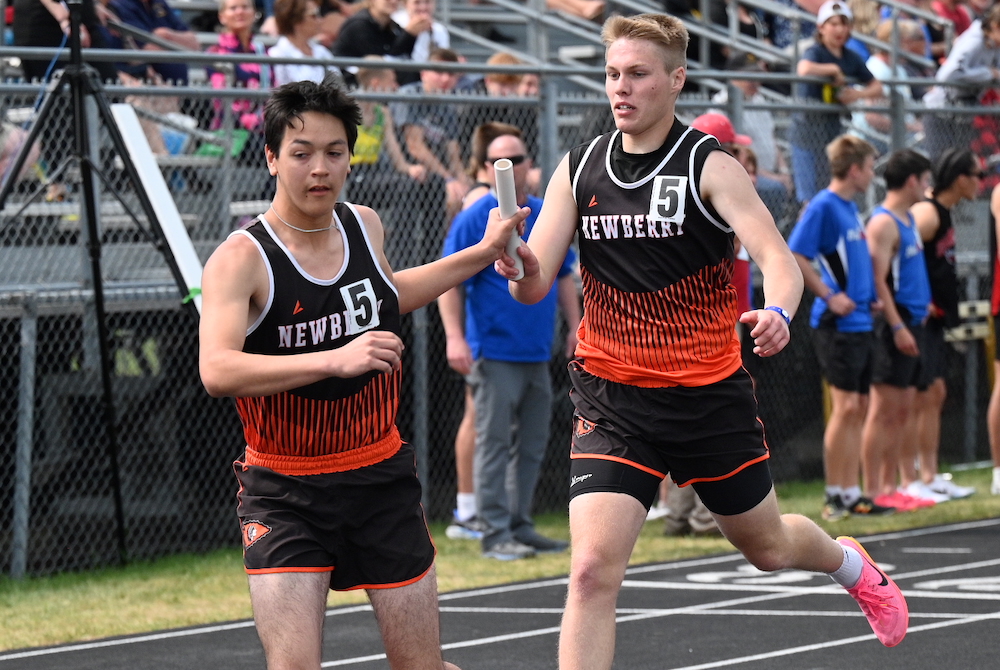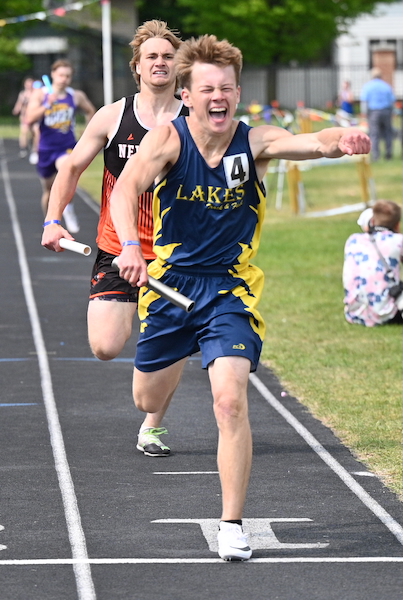
Beecher's Townsend Ready to Lead Chase Among State's Speediest Sprinters
By
Paul Costanzo
Special for MHSAA.com
April 13, 2022
Jaylin Townsend’s introduction to the state’s track & field scene came a year later than planned, but it was quite a first impression.
 As a sophomore, the Flint Beecher star walked out of the Lower Peninsula Division 4 Finals with two individual titles, one relay title and a runner-up finish in another relay.
As a sophomore, the Flint Beecher star walked out of the Lower Peninsula Division 4 Finals with two individual titles, one relay title and a runner-up finish in another relay.
“It kind of surprised me,” Townsend said. “Coming into the season off of COVID, we could barely get into the weight room, and it was hard to get on the track and run. We couldn’t get the blocks out. It was kind of an eye opener, really.”
Despite it being his first season – the 2020 season was canceled completely – Townsend was dominant throughout. He won all but one of the individual races he competed in, with the lone loss coming in the 200 meters in the first meet of the season.
That was quickly corrected, as he cut nearly four seconds off his time in his next meet and never lost the race again.
He won the 100 meters at the Division 4 Finals with a personal best of 10.98 seconds. He won the 200 in 22.75. His personal best in that event is 22.37, which was run in the prelims of the Regional.
Beecher’s relay teams that featured Townsend were equally dominant. The 800-meter relay team suffered just one defeat – disqualification at the Genesee Area Conference championship meet. Townsend, Micah Brown, Danny Bradley and Jacoby Sanders ran a season-best 1:30.59 to win at the Division 4 Finals.
The 400 relay team of Townsend, Bradley, Carmelo Harris and James Cummings II took second at the Division 4 Finals with a time of 44.11. It was their first non-DQ loss of the season.
It was close, but Jaylin Townsend (@Jay23Trip) took home two State Championship medals for Flint Beecher, winning the 100 Meter Dash and the 200 Meter Dash.#StateChamps x @MHSAA pic.twitter.com/BMnhp2GaPV
— STATE CHAMPS! Michigan (@statechampsmich) June 19, 2021
Townsend’s contributions were good for 38 team points, which alone would have placed fourth in Division 4. Beecher as a team finished third with 54 points.
While the immediate success came as a surprise to Townsend, it didn't to his coach.
“I saw it in him,” Beecher coach Joe Wilkerson said. “I knew he could be something special. I told his mother when I talked to her, ‘This guy is going to be a state champ this year.’ There was just something about him that I saw it in him. Lo and behold, he was a three-time state champ. It just made me feel good, because I could trust my own instincts a little bit right now.”
Townsend knows his success will motivate his future opponents even more, but he’s fine with that.
“Going into this year, I know they’re coming for me,” he said. “I know I have to put in some extra work.”
Putting in extra work is something Townsend is used to, as he had to a year ago to get up to speed. He said working on his stride and coming out of the blocks were the main points of emphasis.
“I had to learn a lot, actually,” he said. “Most of the stuff, I was just doing off raw talent. I would make sure to ask Coach, ‘Hey, do you have an extra 30 minutes? Can you stay after?’ My first-ever track meet, when I came out of the blocks, I used to pop right up.”
That has Wilkerson excited, as he believes the sky is the limit for his young star.
 “This guy, he’s exceptional,” said Wilkerson, who has coached track at Beecher on and off since 1979. “I’ve been coaching for a long time, and I’ve never had a student quite like him with that kind of natural ability.”
“This guy, he’s exceptional,” said Wilkerson, who has coached track at Beecher on and off since 1979. “I’ve been coaching for a long time, and I’ve never had a student quite like him with that kind of natural ability.”
Townsend’s focus on track is essentially limited to the spring season, as he also plays football and basketball for the Buccaneers.
“I’ve always been a great athlete, and I wanted to continue to be great,” Townsend said. “Going into basketball, it keeps me in shape for track.”
He was a key reserve forward for the Beecher basketball team, which advanced to the Division 3 Semifinals this season. He plays mostly in the post, despite being a shade under 6-foot-1 and 165 pounds.
Football is the sport he’s most focused on, particularly when it comes to competing in college. He plays receiver, free safety and cornerback for Beecher, and said he’s had talks with Central Michigan, Ferris State and Grand Valley State.
It was his performance on the track, though, that really helped to start those.
“When I started posting the speed, some of the colleges started to look like, ‘Hey, we can use this kid,’” Townsend said. “It helped out a lot.”
Heading into his junior track season, he hopes to turn a few more heads. He knows the best way to do that is to hold off the challengers who now have him in their sights, and continue to improve on his times. His goal is to work his 100 time down to 10.5 and his 200 time into the mid 21s.
“It kind of goes together,” he said. “Coming off last season, it put a target on my back, but it made some college coaches want to come to the track meets. They want to see me run. They want to see my speed. It’s nothing I can’t handle, though.”
 Paul Costanzo served as a sportswriter at The Port Huron Times Herald from 2006-15, including three years as lead sportswriter, and prior to that as sports editor at the Hillsdale Daily News from 2005-06. He can be reached at [email protected] with story ideas for Genesee, Lapeer, St. Clair, Sanilac, Huron, Tuscola, Saginaw, Bay, Arenac, Midland and Gladwin counties.
Paul Costanzo served as a sportswriter at The Port Huron Times Herald from 2006-15, including three years as lead sportswriter, and prior to that as sports editor at the Hillsdale Daily News from 2005-06. He can be reached at [email protected] with story ideas for Genesee, Lapeer, St. Clair, Sanilac, Huron, Tuscola, Saginaw, Bay, Arenac, Midland and Gladwin counties.
PHOTOS (Top) Flint Beecher’s Jaylin Townsend, right, turns a corner as he works to get a pace ahead of Saugatuck’s Benny Diaz on the way to winning last season’s LPD4 200 championship. (Middle) Townsend gets ready to defend during last month’s Division 3 Semifinal against Schoolcraft. (Top photo by Will Kennedy; middle photo by Hockey Weekly Action Photos.)

Newberry Clinches 1st Track & Field Finals Repeat in 2 Decades
By
John Vrancic
Special for MHSAA.com
June 1, 2025
KINGSFORD — Nearly two decades ago, the Newberry boys became Upper Peninsula Division 2 track & field champs in back-to-back years.
They accomplished the same here Saturday, retaining their Division 3 title with 84 points, Runner-up Lake Linden-Hubbell scored 73, with Bessemer a surprising third at 46.
“We kind of did what we had all season,” Newberry coach Drew Schultz said. “We were kind of top heavy. We were lacking depth a little, but I knew if the guys did what they did all season, I liked our chances. This is the first time we won back-to-back years since I was in high school (2005-06). This is fun, bringing four championship trophies back to the eastern U.P. Pickford’s kids did a nice job (sweeping titles) in D-2.”
Newberry started this day on a positive note, winning the 3,200-meter relay in a season-best 8:42.67.
Senior Connor Carlson, who anchored that relay, also placed fourth in the 200 (24.31) and 400 (54.07).
“It feels good to win,” he said moments after finishing the relay. “I love winning. Garrett (Lewicki) ran a great first leg. Everyone was rolling. This sets the tone pretty good.”
Lewicki also anchored the 1,600 relay which placed second (3:42.47), and took third in the open 800 (2:09.83).
Newberry senior Matt Rahilly won long jump at 20-4½ and high jump (6-0), placed second in the 100 (11.51) and third in the 200 (24.24). Classmate Ethan Pavey added a first in shot put (43-6½).
Senior Dakota Taylor, who will run cross country at North Central Michigan College in Petoskey this fall, provided Engadine with a solid showing. He took second in the 3,200 in a personal-best 10:20.96 and third in the 1,600 (4:51.61), and helped the Eagles place fourth in the 3,200 relay (9:08.59).
Brimley swept the sprint relays, taking the 400 (46.78) and 800 (1:36.75), and senior Adrian Kunowski took pole vault (11-1).
“I’d say our handoffs went well,” Brimley sophomore Gus Vonseggem said. “We didn’t qualify last year. Cooper (Jones) and Trey (Lynn) joining the team made a difference. We really wanted to break the school record. We still need to make our handoffs a little better. It takes a lot of offseason work. Overall, we’re happy with the team’s performance.”
Chassell senior and Michigan Tech recruit Kalvin Kytta was a triple-winner, taking the 800 at 2:03.71, 1,600 in a personal-best 4:28.58 and 3,200 (10:11.42).
“I’m very happy with my season,” he said. “I was going for the record in the 3,200, but just couldn’t quite get that today. The PR (personal record) in the mile was kind of a reflection win.
“Glory to God for sure. He gives me the strength to do all this. I’m getting to know the guys a little at Tech. I’m thankful to God for providing me with this opportunity.”
Lake Linden-Hubbell sophomore Lukas Axford captured the 300 hurdles (42.46) and anchored the winning 1,600 relay (3:41.89). Watersmeet senior Thomas Caron was a double winner, taking the 200 (23.91) and 400 (52.36) and adding a fourth in the 100 (11.75).
Bessemer senior Bryce Martin won the 100 (11.44), and sophomore Jayden Verrett was runner-up in the 200 (23.92), third in the 100 (11.52) and anchored two second-place sprint relays.
PHOTOS (Top) Newberry's Garrett Lewicki hands off the baton to Danny Mikus during the 1,600 relay Saturday. (Middle) Lake Linden-Hubbell's Lukas Axford celebrates his team's win in that race. (Click for more from Cara Kamps/RunMichigan.com.)

